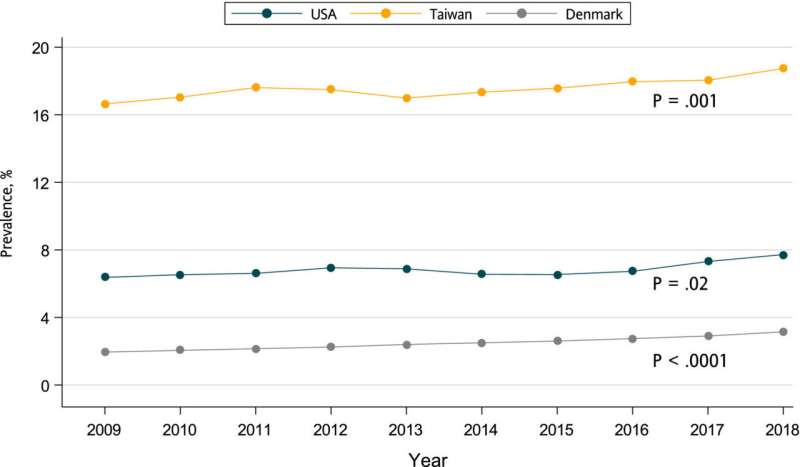This article has been reviewed according to Science X's editorial process and policies. Editors have highlighted the following attributes while ensuring the content's credibility:
fact-checked
trusted source
proofread
Study finds oral steroid usage increased across US, Taiwan and Denmark in past decade

When being treated for an upper respiratory infection, it's common for patients to be prescribed a short course of an oral steroid.
Now, oral steroid prescriptions are being prescribed at an increasing rate, creating a need for patients to be aware of their effects and alternative options that exist.
Research from the University of Michigan finds that, over the past decade, there's been a steady increase of oral steroids prescriptions in the United States, Taiwan and Denmark.
The study, published in Clinical and Translational Science, found that between 2009–2018, overall prevalence of oral steroid use increased from 6.4 to 7.7% in U.S., 16.6 to 18.7% in Taiwan, and from 1.7 to 2.9% in Denmark.
"Oral steroids are commonly given to patients for short amounts of time to help with symptoms related to acute illnesses such as bronchitis or sinusitis, despite there being little data that they are beneficial in treating either of these," said Beth Wallace, M.D., an assistant professor of rheumatology at the University of Michigan.
"We also found that steroids were commonly being prescribed for back problems and skin disorders, when there are alternative treatments that may work better and have fewer side effects."
Short courses of oral steroids have long been viewed as a safe way to treat the symptoms of these common conditions.
Recently, though, researchers have learned that even healthy patients can experience significant side effects from repeated exposure to steroids.
Typical short term side effects of oral steroids are insomnia, mood changes and increased blood pressure and blood sugar.
Patients taking oral steroids for longer periods of time may experience an increased risk of heart attacks, strokes, blood clots or a heightened risk for infections.
"The best way to reduce the risk of these negative side effects is to take the lowest dose of steroids for the shortest period of time and avoid steroid use when there's no evidence to suggest it works," recommended Wallace.
Wallace also encourages providers to look for alternatives to short term oral steroid prescriptions for their patients when treating the symptoms of self-limited illnesses such as bronchitis or sinusitis.
"It is becoming more evident that we as medical practitioners should be thinking about steroids through the lens of stewardship, in the way we already think about antibiotics or opioids," said Wallace.
"By using steroids only when they are indicated, prescribing the lowest dose possible for the shortest time possible, and exploring other avenues for treatment when available, we can help reduce the risk of oral steroid effects for patients."
More information: Beth I. Wallace et al, Prevalence and prescribing patterns of oral corticosteroids in the United States, Taiwan, and Denmark, 2009–2018, Clinical and Translational Science (2023). DOI: 10.1111/cts.13649


















